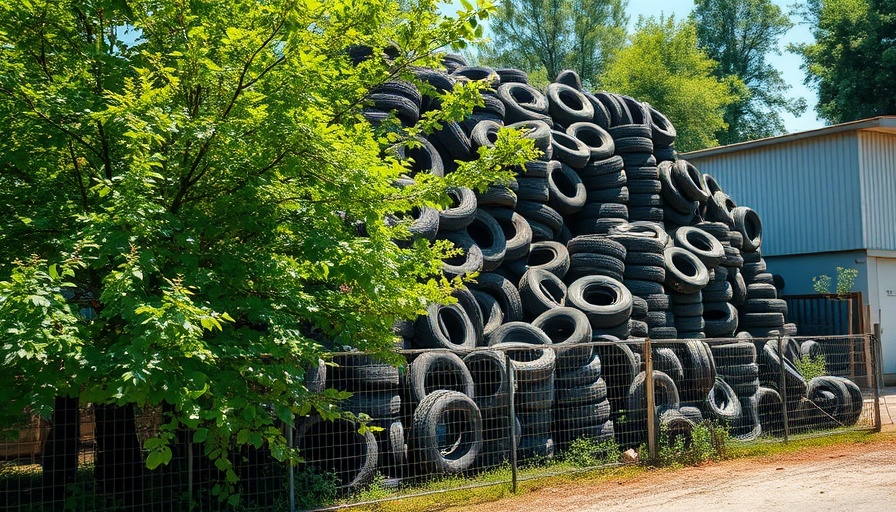
Community Frustration Grows Over Tire Pileup in North Memphis
In the heart of north Memphis, a daunting issue has emerged for residents of the Douglas area, as they grapple with an unsightly and potentially harmful mound of tires accumulating behind their homes. For homeowners like Kevin Hopson, this situation is more than just an eyesore; it significantly impacts their quality of life and their health. "Years ago, you used to be able to come out and sit on the porch, you can’t do that now," laments Hopson, whose backyard is directly adjacent to the tire pile.
Rising Mosquito Populations Spark Health Concerns
The primary concern related to this mound of tires is the drastic increase in mosquito populations. Residents are reporting a surge in these pests, which thrive in the standing water often found in discarded tires. "It is like 100 mosquitoes attacking you at one time," Hopson describes, emphasizing the irritation and discomfort that his family now faces whenever they attempt to enjoy their outdoor space. Annette Murray, a neighbor, echoed this sentiment, noting that local crews attempt to combat the issue through spraying but have found little relief. "I had them spray my grass twice yesterday," she notes, but the results have been disappointing.
The Impact of Rainfall
Persistent rainfall in the region has added to the problem, exacerbating the standing water in the tires and creating a perfect breeding ground for mosquitoes. The accumulation of rainwater not only invites more mosquitoes but could also lead to potential health risks associated with mosquito-borne diseases. The rainy season has created an urgent need for maintenance and removal of these tires, as many families fear the health implications of having such a breeding ground so close to their homes.
Community Response and Property Owner Accountability
Residents like Hopson are calling for action. He acknowledges that the property owners need to take responsibility for the upkeep of their lot, especially given the hazardous conditions their neglect has created. “I mean, I went over there and talked with him… and all the tires were pretty dry, but now with all the rain, I know how terrible it is over there,” he expressed. Homeowners believe that it is essential for property owners to be proactive in addressing this issue by either cleaning up the tires or implementing preventive measures to stop further accumulation.
Seeking Solutions: Potential Strategies for Homeowners
So what can residents do? One immediate action would be to report the issue to local authorities or health departments, as unsightly and hazardous conditions like these may violate local codes. Community advocacy can also play a role in pressuring property managers to take immediate action. Several nearby neighborhoods have successfully organized community clean-up days where residents band together to address local environmental nuisances—such as the accumulation of waste. Constant communication with property owners and local officials can foster a collaborative approach towards maintaining community aesthetics and health.
Potential Long-term Solutions: Prevention is Key
When considering the future, homeowners may want to advocate for stricter regulations regarding waste management and tire storage. Policies encouraging safe disposal and recycling of tires can help reduce similar occurrences in the future. Community meetings could serve as platforms for residents to voice their concerns and discuss potential solutions with local leaders. This proactive stance is both beneficial to homeowners and enhances the overall well-being of the community.
Community Discontent: The Personal Toll
The emotional toll of this situation cannot be understated. Hopson and Murray both express a sense of helplessness and frustration in not being able to enjoy their homes, a fundamental source of comfort. "With summer in full swing, I plan on spending a lot of time inside," Hopson concluded, yearning for the days when families could easily slip outside without fear of being bombarded by mosquitoes. The visible impact of the tires is not just physical; it stirs concern in homeowners as they reflect on their sanctuary turning into a battleground for mosquitoes.
Conclusion: The Call for Action
As the mound of tires continues to grow, so does the attention it garners from concerned residents. Community stakeholders—including local government and health officials—must step in swiftly to address the immediate hazards and work with property owners to establish long-term solutions. The vitality of the neighborhood and the health of its residents deserve to be prioritized. It is crucial for the community to rally together for a collective solution that restores the dignity and livability of their homes.
 Add Row
Add Row  Add
Add 



 Add Row
Add Row  Add
Add 
Write A Comment